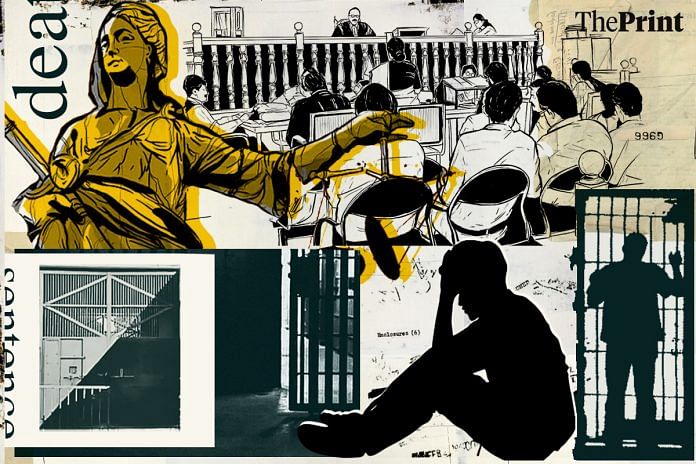New Delhi: What’s a more humane way to execute death-row convicts? Lethal injections or death by hanging? It’s a question that confronted the Supreme Court as it heard an eight-year-old petition seeking to replace the age-old method of hanging with lethal injection because it was quicker and more painless.
While acting on a public interest litigation (PIL), the top court on Wednesday pulled up the central government for opposing the suggestion that death-row convicts should be given lethal injections instead of being hanged.
A bench of Justices Vikram Nath and Sandeep Mehta said the government was “not ready to evolve” even though hanging was an age-old method and times had changed.
The matter was shifted for further hearing on 11 November.
The court was acting on a plea by senior advocate Rishi Malhotra, who said that death by hanging should either be abolished altogether since it’s an “inhumane and barbaric” method, or it should be replaced by lethal injection, which is a quicker and more painless way. Hanging remains the prevalent method in India for execution of death-row convicts.
Malhotra said countries like the US, China, Vietnam and Thailand already use lethal injections to execute prisoners. He added that 49 out of 50 states in the US have already adopted lethal injection as their method of execution. He also argued in his petition that death by hanging is unconstitutional as it violates the right to life under Article 21 of the Constitution. His plea argued that hanging leads to prolonged pain and suffering.
Asserting that the right to die with dignity is a fundamental right, the plea noted that the entire execution process takes 40 minutes, as opposed to lethal injections, which take only five minutes.
The lawyer also made clear that he was not challenging the imposition of the death penalty, as a Constitution Bench had already ruled that it is permissible in the rarest of the rare cases, in the 1980 Bachan Singh vs State of Punjab case.
The petition dates back to 2017, but still awaits an outcome. In 2018, the Centre opposed abolishing death by hanging for convicts, saying it wasn’t “practically feasible” and was a policy decision that should be kept out of the court’s ambit.
Two years ago, the court had deliberated upon setting up an expert committee to examine the impact of death by hanging, the time taken for the death among other issues.
Malhotra told ThePrint it was evident from the Law Commission reports and the Supreme Court rulings that death should be dignified. “The 1987 report, which compares all methods of execution from hanging to electrocution, found that hanging takes 40 minutes for a person to be declared dead, and as a result is a very cruel and barbaric method, whereas lethal injections first make the prisoner unconscious and then execute him,” he said.
Underlining that the Army and Air Force Acts also give prisoners the option of choosing hanging or other methods, Malhotra said, “Why shouldn’t other prisoners be given this choice? Hanging is carried out by laypersons like hangmen while injections are administered by skilled technicians.”
India’s legal position
Section 354(5) of the erstwhile Code of Criminal Procedure (CrPC), now replaced with 393(5) of the Bharatiya Nagarik Suraksha Sanhita (BNSS), says that a person sentenced to death shall be executed by hanging by the neck until they are dead.
The provision allows for the death of prisoners who have been convicted of capital offences like murder, rape, terrorism and military offences. In 1983, this provision was challenged in the case of Deena Deen Dayal vs Union of India, but the top court held that the provision is fair, reasonable, constitutional, and in line with the contours of Article 21.
Hanging requires weighing the prisoner, measuring the rope, and sometimes even using cranes to hang the prisoners publicly.
Apart from India, Afghanistan, Bangladesh, Egypt, Japan, Kuwait, Singapore, Iran, Iraq, Malaysia, Nigeria and South Sudan Japan also follow this method.
In many countries, like the US, executions are carried out by lethal injections, gas chambers and electrocution, in addition to hanging.
Although hanging was the primary method of execution used in America until the 1890s, the last reported hanging was in 1996, in the state of Delaware, according to the Death Penalty Information Centre.
Several serial killers in the US, such as John Wayne Gacy, Aileen Wuornos and William Bonin, also known as the ‘Freeway Strangler’, were executed by this method.
According to Amnesty International’s annual death penalty report, the lethal injection method—proposed as quicker and relatively painless—consists of three chemicals: sodium pentothal, an anaesthetic; pancuronium bromide, which paralyses the prisoner; and potassium chloride, which stops the heart. The report said this method is followed in the US, China and Vietnam, but added that these executions don’t always work as planned.
In 2014, for instance, an Ohio man took over 20 minutes to die by lethal injection.
Other methods include death by shooting or even gas chambers. Firing squads are used in countries like China, Indonesia, North Korea, Saudi Arabia, Somalia, Taiwan and Yemen, where prisoners are tied to a pole with their heads covered. Saudi Arabia beheads its prisoners as well. Gas chambers are used in the US, where a poisonous nitrogen gas is released to asphyxiate the victims.
(Edited by Sugita Katyal)
Also Read: RG Kar case falls in ‘rarest of rare’ doctrine. Sanjay Roy deserves death penalty






